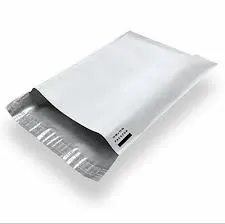sugar cane mailing bags
The Importance of Sugar Cane Mailing Bags in Sustainable Packaging
In recent years, the emphasis on sustainable practices has brought forth a significant evolution in the packaging industry. One notable innovation is the use of sugar cane mailing bags, a sustainable alternative that is gaining traction among eco-conscious consumers and businesses alike. This article delves into the environmental benefits, practicality, and growing popularity of sugar cane mailing bags as a preferred choice for shipping and packaging.
What Are Sugar Cane Mailing Bags?
Sugar cane mailing bags are made from a renewable resource sugar cane, a tropical plant that is primarily grown for sugar production. After sugar extraction, the leftover cane fibers, known as bagasse, can be converted into bioplastics, providing a viable material for creating durable and lightweight mailing bags. These bags serve as an eco-friendly alternative to traditional plastic mailing bags, which contribute significantly to plastic pollution and environmental degradation.
Environmental Benefits
One of the most compelling reasons to switch to sugar cane mailing bags is their positive impact on the environment. Firstly, the production of sugar cane bags involves less energy and water compared to conventional plastic bags, reducing the overall carbon footprint. In addition, sugar cane is a carbon-neutral crop; it absorbs carbon dioxide during its growth cycle, offsetting the emissions produced during its processing.
Moreover, unlike traditional plastic bags, sugar cane mailing bags are biodegradable and compostable. This means that they can break down naturally in a landfill or composting environment, significantly minimizing the long-lasting pollution associated with petroleum-based plastics. The ability for these bags to decompose effectively reduces the amount of waste entering landfills and helps conserve wildlife habitats.
Practicality and Versatility
In addition to their ecological advantages, sugar cane mailing bags are also practical for various shipping needs. These bags are designed to withstand the rigors of transportation, ensuring that products arrive intact. Their lightweight nature allows businesses to save on shipping costs, as lighter packages often incur lower postage fees.
sugar cane mailing bags

Sugar cane mailing bags also offer versatility in use. They come in various sizes and styles, making them suitable for shipping a wide range of products—from clothing and accessories to books and cosmetics. Moreover, they can be customized with branding designs, allowing businesses to maintain their unique identity while adhering to environmentally friendly practices.
Growing Popularity Among Consumers and Businesses
The rising awareness of environmental issues has prompted consumers to make more conscientious purchasing decisions. Many individuals actively seek out companies that prioritize sustainability in their operations. As a result, businesses are increasingly adopting sugar cane mailing bags to meet consumer demand for greener packaging options.
Several major brands have already embraced sugar cane bags, elevating their marketing strategies to highlight their commitment to the environment. This shift not only boosts brand reputation but also fosters customer loyalty, as many consumers feel empowered when supporting businesses that align with their values.
Challenges and Considerations
While the adoption of sugar cane mailing bags is on the rise, there are challenges that need to be addressed. One significant concern is the perception of bioplastics and their capabilities. Some consumers may be skeptical about the durability or performance of sugar cane bags compared to traditional plastics. Educating consumers about the product's benefits and reliability is crucial for wider acceptance.
Additionally, there is a need for comprehensive recycling systems for bioplastics. Although sugar cane bags are biodegradable, they must be disposed of correctly to ensure they decompose effectively. Promoting a robust waste management system that supports composting and recycling will play a pivotal role in maximizing the environmental advantages of these bags.
Conclusion
As we continue to grapple with the environmental challenges posed by plastic waste, sugar cane mailing bags stand out as a sustainable solution in the packaging industry. Their eco-friendly composition, practicality, and growing acceptance among consumers showcase a positive shift towards greener practices. By making the transition to sugar cane mailing bags, businesses can contribute to a healthier planet while meeting the evolving demands of environmentally aware customers. As we move forward, it is essential for consumers and companies alike to champion sustainable packaging choices that will ultimately foster a more sustainable future for everyone.
-
The Best Uses for Small Trash Bags in Daily LifeNewsJul.01,2025
-
Stylish Reusable Grocery Bags TrendsNewsJul.01,2025
-
Shipping Advantages of Using Bubble Envelopes BulkNewsJul.01,2025
-
How Compostable Mailing Bags Reduce Environmental ImpactNewsJul.01,2025
-
Environmentally - Friendly Bulk Poly MailersNewsJul.01,2025
-
Eco Friendly Custom Laminated Tote BagsNewsJul.01,2025
-
Have the freedom of customizing your custom mailers any way you want! Our dedicated packaging support will help deliver you the mailing experience you need to elevate your shipping experience to the next level! Start making a strong impression on your customers and stand out from your competitors! -
LIYA uses high quality raw materials which directly purchased from large enterprises domestic and overseas such as PetroChina, Sinopec, Sabic, Equate, ExxonMobil, Dow Chemical, Total, and Borouge, ensuring the price advantage and quality of the raw materials. -
LIYA uses high quality raw materials which directly purchased from large enterprises domestic and overseas such as PetroChina, Sinopec, Sabic, Equate, ExxonMobil, Dow Chemical, Total, and Borouge, ensuring the price advantage and quality of the raw materials.





